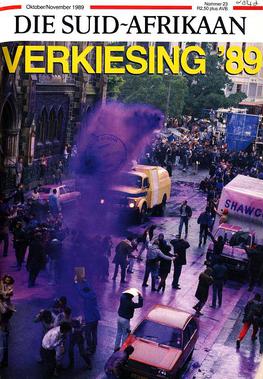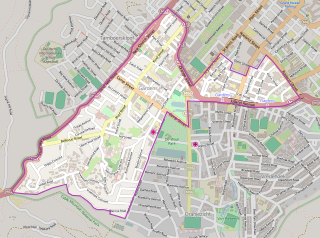
Church Square, originally Market Square, is the square at the historic centre of the city of Pretoria, Gauteng, South Africa. The founder of Pretoria, Marthinus Pretorius, determined that the square be used as a market place and church yard. It was subsequently named for the church buildings that stood at the centre of the square from 1856 to 1905. The square's most prominent feature, since June 1954, is the statue of the late Boer leader and president of the South African Republic, Paul Kruger, at its centre. Statues of four anonymous Boer citizen-soldiers surround that of Kruger on a lower level of the plinth.

Sandton City is a large shopping centre situated in Sandton, Johannesburg, South Africa. It was built and owned by property development company Rapp and Maister, in partnership with brothers Hilliard and Eli Leibowitz, and was later taken over by Liberty Life.
Palilula is a municipality of the city of Belgrade. It has the largest area of all municipalities of Belgrade. The core of Palilula is close to the center of the city, but the municipality also includes sparsely populated land left of the Danube.
Bruma is a suburb of Johannesburg, South Africa. In the 1990s Bruma was well known for South Africa's first manmade lake-side shopping centre and its popular African curios and crafts market, which attracted tourists and day visitors from around the country. As a popular entertainment destination, Bruma boasted many activities and a plethora of restaurants and retail stores. Many of South Africa's large restaurant chain stores can find their roots at the then-called Fishermans Village. Well-remembered restaurants and entertainment venues included Late Night Al's, Norma Jeans Diner, The Grillhouse, Maresol, Helen of Troy, Johnny Rockets, Cocktails and The Magic Company. Other well-known stores were The Spy Shop, Sweets from Heaven, Woolworths Foods, The Swatch Shop, and the current Caltex Fuel station.

Cape Town City Hall is a large Edwardian building in Cape Town city centre which was built in 1905. It is located on the Grand Parade to the west of the Castle and is built from honey-coloured oolitic limestone imported from Bath in England.

Brackenfell is a town in the Western Cape province of South Africa and a northern suburb of Cape Town, situated about 30 km north-east of the city.

Durbanville, previously called Pampoenkraal, is a town in the Western Cape province of South Africa, part of the greater Cape Town metropolitan area. Durbanville is a semi-rural residential suburb on the north-eastern outskirts of the metropolis surrounded by farms producing wine and wheat.

The Purple Rain Protest, Purple Rain Revolt or Purple Rain Riot was an anti-apartheid protest held in Cape Town on 2 September 1989, four days before South Africa's racially segregated parliament held its elections. A police water cannon with purple dye was turned on thousands of Mass Democratic Movement supporters who poured into the city in an attempt to march on South Africa's Parliament. White office blocks adjacent to Greenmarket Square were sprayed purple four stories high as a protester leapt onto the roof of the water cannon vehicle, seized the nozzle and attempted to turn the jet away from the crowds.

Observatory is a suburb in Cape Town, South Africa, colloquially known as Obs. Bordered by Mowbray to the south and Salt River to the northwest, the area is best known as a student neighbourhood associated with the nearby University of Cape Town and Groote Schuur Hospital. It takes its name from the South African Astronomical Observatory headquarters, built in 1829 by the Royal Observatory.

The Chennai Suburban Terminal, or Moore Market Complex, is a railway terminus cum commercial building complex for the Chennai Suburban Railway system, situated in Park Town in Chennai, India. The name Moore Market comes from a market that used to exist at the site before being demolished to make way for the expansion of the MGR Central station.

Gardens is an affluent inner-city suburb of Cape Town located just to the south of the city centre located in the higher elevations of the "City Bowl" and directly beneath Table Mountain and Lion's Head. It is home to several national museums such as Iziko South African National Gallery and the Iziko South African Museum. The University of Cape Town also houses its Fine Arts department in the suburb, at Michaelis School of Fine Art. Company's Garden, South Africa's oldest garden, a public park and heritage site is a focal point of the suburb. The area is also home to the oldest synagogue in Southern Africa, the Old Shul and its successor, the Gardens Shul, "The Mother Synagogue of South Africa."
Badih Chabaan was a PR councilor in the Cape Town City Council. He was a member of the Africa Muslim Party (AMP) when he was named councilor in August 2006 but later crossed the floor to establish the National People's Party (NPP), which he led as president. In November 2015, he announced his intention to resign from politics and hand over NPP leadership to his daughter.
Drottningtorget is a major public square in central Malmö, Sweden. It lies between the main town square and Värnhem. The area dates back to at least the Middle Ages when the Adelgatan, one of the city's main streets, led to it and it became an important peasant trading centre. However, the modern square was built in the 1810s, when the old fortifications surrounding the town were removed.

The following outline is provided as an overview of and topical guide to Cape Town:

The Greenmarket Square refugee sit-in was a sit-in protest by a group of refugees for the purpose of getting relocated to a country outside of South Africa in response to xenophobia in the country. It lasted from 8 October 2019 when protestors first occupied the Waldorf Arcade to 2 April 2020 when the last group of protestors were evicted from the Central Methodist Mission church. The protestors demanded that UNHCR assist them with being relocated to a third country outside of South Africa and other than their country of origin. At its height the protest grew to include about 624 protestors, including 65 undocumented refugees, according to a lawyer for the South African Department of Home Affairs.

Sturk's Tobacconists is a tobacconist based in Greenmarket Square, Cape Town, South Africa. Founded on 1 August 1793 is notable for being the oldest tobacconist and possibly oldest business in South Africa. Its physical location closed down due to the COVID-19 pandemic and resulting tobacco sales ban during the pandemic lockdown period.

The Central Methodist Church, also known as the Central Methodist Mission or Metropolitan Methodist Church, is a large and historically important Methodist church located on Greenmarket Square in Cape Town, South Africa. The church has played a significant role in the growth of Methodism in South Africa. In 1988, the Metropolitan Church merged with Buitenkant Street Church, forming the Central Methodist Mission.



















